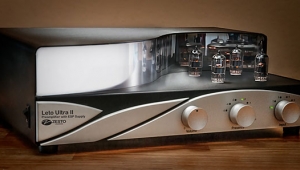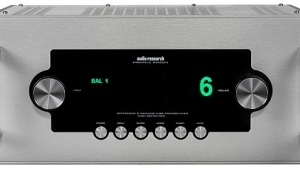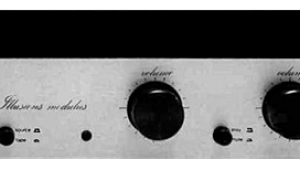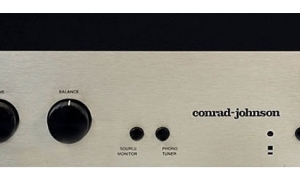| Columns Retired Columns & Blogs |
Musical Fidelity AMS Primo line preamplifier Measurements
Sidebar 3: Measurements
I used Stereophile's loan sample of the top-of-the-line Audio Precision SYS2722 system (see the January 2008 "As We See It" and www.ap.com) to examine the Musical Fidelity AMS Primo's measured behavior; for some tests, I also used my vintage Audio Precision System One Dual Domain.
For both balanced input to balanced output and unbalanced input to unbalanced output with the Primo's Gain switch operative, the maximum voltage gain was a sensible 12.5dB. (The Gain switch added exactly 6dB to the level of unbalanced sources, to match balanced ones.) The unity gain setting of the volume control was 1:00. The XLRs are wired with pin 2 hot, and all inputs and outputs preserved absolute polarity; ie, were non-inverting.
The input impedance was very high, at 153k ohms at 1kHz unbalanced and 266k ohms at 1kHz balanced. These values were measured with the rear-panel switch set appropriately for each input, and remained the same down to 20Hz. They did drop slightly but inconsequentially at 20kHz, to 81k and 182k ohms, respectively. This Musical Fidelity preamp will hardly load the source components to which it is connected. The Primo's output impedance was low for an all-tube design, at 604 ohms balanced and 385 ohms unbalanced, at midrange and high frequencies. It did rise slightly in the low bass, to 766 ohms balanced and 435 ohms unbalanced, but this will not have any practical consequences.
Into the high 100k ohms laboratory load, the Primo offered a very wide bandwidth, the –3dB point for balanced operation lying at 140kHz (fig.1, blue and red traces). Commendably for a tubed design, this bandwidth was not significantly affected by the volume-control setting, though it did decrease a little with the punishing 600 ohm load (fig.1, cyan and magenta traces). The low frequencies also started to roll off a little prematurely with this very low load impedance.

Fig.1 Musical Fidelity AMS Primo, volume control at maximum, frequency response at 1V into 100k ohms (left channel blue, right red) and 250mV into 600 ohms (left cyan, right magenta). (0.25dB/vertical div.)
Crosstalk for fully balanced operation was buried beneath the noise floor (fig.2, blue and red traces), but channel separation rose with increasing frequency with unbalanced operation (fig.2, cyan and magenta). It was still a good 78dB at the top of the audioband, however. This graph suggests that the noise floor was higher in the left channel than in the right, and this was confirmed by the unweighted, wideband signal/noise ratio (with the input shorted but the volume control at its maximum): 91.3dB right but 87.1dB left, both figures ref. 1V output. I imagine that this difference was due to a noisy tube in the left channel, but the noise in the left channel is still low in absolute terms. The A-weighted ratios were excellent, at 91.1dB left and 103dB right.

Fig.2 Musical Fidelity AMS Primo, channel separation, balanced input to balanced output (L–R blue, R–L red) and unbalanced input to unbalanced output (L–R cyan, R–L magenta).
The lower trace in fig.3 plots the THD+noise percentage present in the Primo's balanced output against the level of a 1kHz signal. The preamplifier doesn't clip into 100k ohms (defined as 1% THD+N) until the output level reaches an enormous 34V—way above what the preamp will be required to deliver in real life. But note, from the shape of the lower trace in fig.3, that the distortion is buried beneath the noise below an output level of 3V. As the maximum output voltage the Primo will be required to deliver in a real-world system will be around 4V, this suggests a sensible gain architecture. However, into the, admittedly, unrealistically low 600-ohm load (fig.3, upper trace), the preamp clips at just over 1V output. Fig.4 shows similar behavior for unbalanced operation, but with the maximum output half that available from balanced operation. The Primo should be used with power amplifiers having a sensibly high input impedance. How high is "sensibly" high? The middle trace in fig.4, taken into 10k ohms, reveals that while the preamp doesn't clip prematurely, it is still starting to get a bit uncomfortable above levels of a few hundred millivolts. At least 20k ohms is recommended, therefore; as the Musical Fidelity Titan that MF used for his auditioning offers 10 times that value, he was hearing the Primo at its best—ie, with the lowest distortion and noise.

Fig.3 Musical Fidelity AMS Primo, THD+N (%) vs balanced output voltage at 1kHz into (from bottom to top): 100k, 600 ohms.

Fig.4 Musical Fidelity AMS Primo, THD+N (%) vs unbalanced output voltage at 1kHz into (from bottom to top): 100k, 10k, 600 ohms.
The bottom pair of traces in fig.5 show that that distortion into 100k ohms is very low indeed, though it does start to rise in the top two octaves due to the circuit's usual lack of gain-bandwidth product in this region. The distortion is high into 600 ohms (fig.5, top pair of traces), as expected from fig.3, but uniform with frequency. This graph was taken with balanced operation; the THD+N percentage was typically 0.012% at 2V into 100k ohms.

Fig.5 Musical Fidelity AMS Primo, balanced output, THD+N (%) vs frequency at 4V into 100k ohms (left channel blue, right red) and 500mV into 600 ohms (left cyan, right magenta).
The spectrum of a high-level balanced tone into 100k ohms is shown in fig.6. Again the left channel (blue trace) can be seen to be noisier at low frequencies than the right channel (red). However, while the right channel offers the second harmonic at –90dB (0.003%) and the third harmonic at –100dB (0.001%), the left channel has only the third harmonic apparent, at –96dB (0.0015%). With the circuit's absence of loop negative feedback, these differences are, like the differences in noise performance, presumably related to the tubes used; the left channel's tubes are matched more closely than the right channel's, eliminating the residual even-order distortion. Reducing the load impedance to 600 ohms dramatically raises the level of the third harmonic in both channels, and of the second harmonic in the left channel (fig.7). However, the fact that the harmonics present in this worst-case condition are still only the subjectively innocuous second and third, with no high-order spuriae visible, is a good sign.

Fig.6 Musical Fidelity AMS Primo, balanced output, spectrum of 1kHz sinewave, DC–10kHz, at 4V into 100k ohms (left channel blue, right red; linear frequency scale).
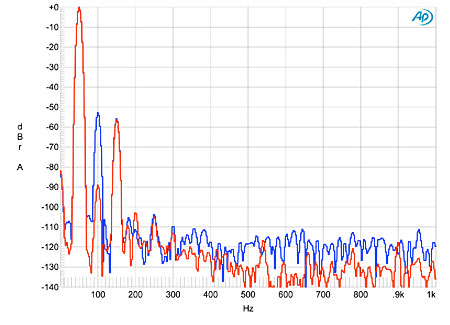
Fig.7 Musical Fidelity AMS Primo, balanced output, spectrum of 1kHz sinewave, DC–10kHz, at 500mV into 600 ohms (left channel blue, right red; linear frequency scale).
Finally, even with its decreasing linearity in the top octaves, the Primo offers low levels of intermodulation distortion with the torture test of equal levels of 19 and 20kHz tones (fig.8). The second-order difference product at 1kHz is higher in the left channel than the right, at –84dB (0.006%) compared with –100dB (0.001%), but this is still very low.

Fig.8 Musical Fidelity AMS Primo, balanced output, HF intermodulation spectrum, DC–24kHz, 19+20kHz at 4V peak into 100k ohms (linear frequency scale).
Provided it is used with a power amplifier having an input impedance of at least 20k ohms, the Musical Fidelity AMS Primo offers superb measured performance, with only the slight differences in left- and right-channel noise and linearity giving any indication that its circuit exclusively uses tubes. And in any case, those departures from perfection will not even be close to audibility under normal conditions.—John Atkinson
- Log in or register to post comments







